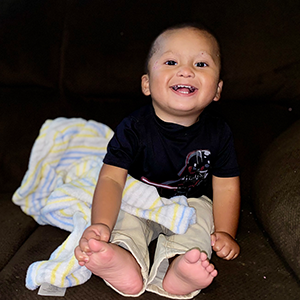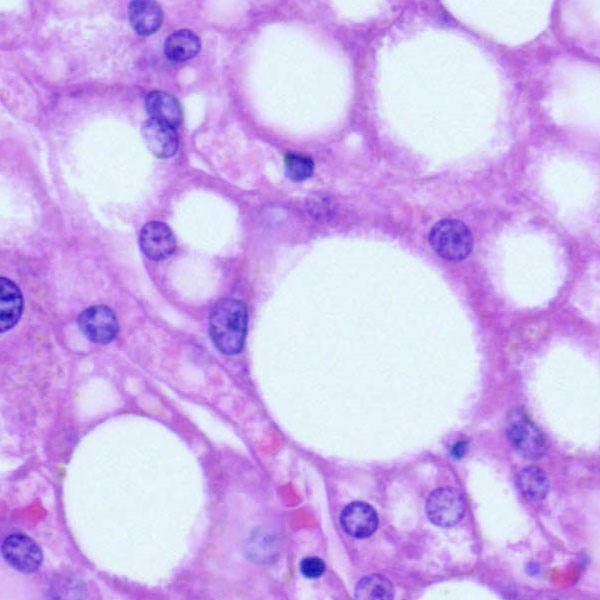-
Discovery’s Edge: Plugging into drug discovery
The research laboratory of Mayo Clinic pediatric oncologist Richard J. Bram, M.D., Ph.D., was enjoying the kind of success many researchers hope for. His team in Rochester, Minnesota, had long been interested in studying brain tumors, particularly those in children.
"They're the second most common malignancy in children, but the development of cures has lagged," Dr. Bram says.
Dr. Bram's research team made a big discovery: They found that a particular protein called cyclophilin B turned up in abundance in glioblastomas and medulloblastomas, two deadly nervous system tumors.
The protein seemed to be critical to these two cancers. When researchers blocked the protein in cell samples, the tumors died. Even more impressively, when they genetically eliminated the protein in mice, the mice continued to behave normally.
"The findings suggested the protein could be a good target for a drug, selectively killing tumor cells and having a minimal effect on normal ones," Dr. Bram explains.
But elation was quickly tempered by practicality. Researchers at Mayo Clinic had long taken note of the formidable gulf that often exists between discoveries in the lab and the development of new drugs.
Drug development out of reach for Mayo Clinic
Dr. Bram was well aware that the next steps in creating a therapy for brain cancers based on his findings could take more than a decade, and, according to some industry figures, cost as much as $2 billion for research and development. And Dr. Bram knew that pharmaceutical companies wouldn't likely be interested in the finding about the cyclophilin B protein because the market for brain tumor drugs is fairly small.
"At that point," Dr. Bram recalls, "we said it would be great if somebody somewhere would look into creating a drug, but it won't be us, and it won't be in our lifetime."
As it happened, somebody was about to ruin his prediction.
For years, drug development has been directed by the business-minded pharmaceutical industry, which tends to shy away from risky projects and those geared toward smaller potential markets, focusing instead on products that are likely to pay off big.
"This means very promising research can fall by the wayside," says infectious disease specialist Andrew D. Badley, M.D., associate director of Mayo Clinic's research resources, the services and technologies that are shared among the institution's scientists.
In 2012, several Mayo Clinic scientists approached Dr. Badley, wanting to know whether Mayo Clinic could create its own drug development facility.
"Out of the realm of possible," was what Dr. Badley quickly determined after looking into the pricey and uncertain steps involved.
"Drug companies that do this kind of development have tens of millions of dollars and hundreds of personnel invested in these projects," noted Badley, who is at Mayo Clinic's campus in Minnesota. "An investment of that scale was out of reach for Mayo to undertake alone."
Partnering with Sanford-Burnham Medical Research Institute
Serendipitously, Sanford-Burnham Medical Research Institute, a laboratory-based institute headquartered in La Jolla, California, had been seeking a partner with deep clinical experience and unique insights into the molecular basis of disease.
In an effort led by Dr. Badley, Mayo Clinic entered into a formal collaboration with Sanford-Burnham in early 2013, after a yearlong pilot phase, to expand and speed the development of new therapeutic drugs aimed at a variety of diseases with serious unmet medical needs.
Sanford-Burnham boasts one of the world's largest libraries of chemical compounds and has the ability to perform robotic ultrahigh throughput screening, matching those compounds with biological molecules.
With its 900 scientists at campuses in La Jolla and Lake Nona, Florida, Sanford-Burnham is one of four centers in the country funded by the National Institutes of Health to develop vast molecular libraries of compounds that are drug candidates. It invested $30 million in complex robotics that systematically can test half a million compounds in less than a week. Its Ph.D. researchers include experts in chemical-screening technologies, medicinal chemistry — to tinker with chemicals so that they can be metabolized by the body and can reach their targets within cells — pharmacology and the fundamental biological processes related to disease.
Unlike big pharmaceutical companies, Sanford-Burnham had not zeroed in exclusively on blockbuster drugs that might treat millions, but had looked more widely at taking early projects to the next stage. Its track record already included 250 proof-of-concept studies, in which early-stage research projects were developed to determine the feasibility of drugs for rare diseases with a small market.
"We were looking for a like-minded partner," explains Michael Jackson, Ph.D., Sanford-Burnham vice president of drug discovery and development. "In particular, an organization that considered drug discovery and development of therapeutics as part of their mission, regardless of whether it made money. We had contacted several top clinical research institutions in the world."
No one could have anticipated the energy and enthusiasm when Mayo Clinic and Sanford-Burnham met. As the two research entities began formally working together last year, basic science findings like those of Dr. Bram's became prospective candidates for a drug development pipeline.
HIV, brain tumors among collaborative research projects
The initial plan was to identify research projects that, like Dr. Bram's, had hit a wall, and then determine their feasibility for drug development. When Dr. Badley reached out to numerous research centers at Mayo Clinic to find out what projects were ripe for the next stage, he was astounded by the immediate response. Thirty researchers had findings that seemed to point to druggable targets.
The Mayo Clinic-Sanford-Burnham collaboration ultimately zeroed in on seven pilot projects, spanning a wide range of diseases, with identifiable targets that might be addressed with a chemical compound. The projects were based on findings related to brain tumors, Parkinson's disease, gastrointestinal cancer and HIV.
"Studies got started before we even signed the final agreement," Dr. Jackson says. "We were that confident we wanted to work together."
Then the real challenges began.
NIH funds cyclophilin B project
A team led by Sanford-Burnham molecular pharmacologist Eduard Sergienko, Ph.D., director of assay development, designed a novel test to find compounds that bind to cyclophilin B. The research team found several hits in molecules that seemed to be highly selective for the protein.
This was no small feat.
A compound must bind to the protein in just the right way to block its function. In addition, not all hits turn out to be optimal drug candidates. Ultimately, a truly effective drug will bind exclusively with cyclophilin B and not with other cyclophilin proteins, which are necessary for other cell processes.
Cyclosporin, a common and powerful immunosuppressant drug, is known to bind with all the cyclophilins and can cause dangerous toxicity at high levels.
"When we did the second round of screening to confirm the hits, we had a very high confirmation rate, which was very exciting," Dr. Sergienko says. "That suggested we were looking at real hits, not artifacts, and we could move on from there to purchase and test select compounds."
At the end of the first heady year of collaboration, Dr. Bram's discovery was one of two pilot projects that had acquired enough data to open new doors. The Mayo Clinic-Sanford-Burnham teams submitted evidence of the hits in drug-development grant applications to the National Institutes of Health.
The cyclophilin B project was funded, providing nearly $1.5 million dollars to push the research ahead in the coming three years.
The next steps of research will involve testing the degree to which the candidate compounds bind and interfere with the cyclophilin B protein and expanding the screen to look for additional compounds that may lend themselves well to drug discovery.
After that, the best compounds will be tested in culture with actual glioblastoma cells to see whether they kill tumor cells.
The collaboration has now applied for another six federal grants and is working on developing additional projects beyond the original seven.
"I know it's already impacting the way researchers are thinking about and planning investigations," Dr. Badley says. "Numerous researchers have called me to say they have exciting new insights into treating the disease they are studying. They've heard about this initiative and want to know how they can get involved."
Overhauling the drug discovery model
Dr. Jackson believes the new collaboration — where promising science moves into a pipeline, despite the initial risk — might be a game changer.
"This has the potential to overhaul the drug discovery model," he says. "Between our two research entities, we could go all the way from understanding something about a disease and what component of the human body to target to making a drug that actually would be a clinical candidate."
But for every project, many steps remain before drugs are available to patients, from refining and optimizing compounds to Food and Drug Administration approval.
One of those steps is conducting clinical trials. Ultimately, as compounds are identified, refined by medicinal chemists and tested, the researchers envision engaging pharmaceutical companies to conduct large phase II and phase III clinical trials.
An undeniable strength of the collaboration is suitability of conducting clinical trials at Mayo Clinic, where new drugs can be tested on patients for whom standard therapies have not been effective.
Adding philanthropy to the funding model
Additional funding also is needed to keep these research projects afloat.
In addition to seeking federal funding to advance the research, the initiative will seek philanthropic donors who are eager to invest in drug discovery based on Mayo Clinic findings.
"Because federal funding rates are at an all-time low, additional sources will be essential for the kind of progress we'd like to see," Dr. Badley says.
But researchers involved in the drug discovery partnership with Mayo Clinic and Sanford-Burnham are hopeful about the road ahead and the prospects of helping patients.
"The real key to making health better is to be able to go from bench to bedside," Dr. Badley says. "We've always aimed for that as an institution, and there have been marvelous successes, but this marks a new opportunity to turn findings into therapies that can make a difference in our patients' lives."
Related Articles







